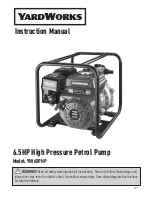
Instruction Manual for F1300/1600 Mud Pump
24
3.1.5 Main bearing cover
Remove the main bearing cover and check tightness of main bearing retainer blots, condition of the
bearing rollers, etc. Clean and remove any sludge or foreign substance that might have accumulated
at the bottom of the bearing area.
3.1.6 Main gear and pinion teeth
Inspect the condition of the main gear teeth and pinion gear teeth for any indications of abnormal
wear. During the initial break-in period there will be some pitting on the face of the gear teeth. This is
referred to as“initial pitting”and is not harmful to the life of the gear. However, if routine inspection
indicates the degree of pitting continues to increase, immediately contact the pump manufacturer for
a more thorough inspection of the gear.
3.1.7 Crosshead pin bolts and crosshead guides
Remove the cover of crosshead bore and check condition of the crosshead pin bolts and lock wires.
(Center crosshead pin bolts can be reached by removing back cover and placing eccentric on outer top
dead center). Tighten crosshead bolts M24X70 (Item 3 Fig .14) with the torque: 225-240 N.m
(165-175ft.lbs). Do not exceed these valves above when using torque wrench.
If the crosshead or guide shows abnormal wear or scoring, replace immediately because it can cause
damage to the bearings, etc; Excess wear can also cause rapid wear to the piston and liner.
3.1.8 Oil and oil reservoir
Check condition of the oil and cleanliness of the oil reservoir. Service oil system is described in the
Lubrication Section of this manual.
3.2 Roller Bearings
Roller bearings are adopted by F series mud pumps. A roller bearing is a precisely built machine within
itself; therefore, careful handling is required in order to obtain the long service life and high load
carrying characteristics associated with anti-frication bearings.
The main bearings are self-aligning spherical roller bearings. The pinion shaft is straight roller bearings.
The eccentric bearings are straight roller with thrust plates on each side to keep the eccentric straps
in line, and the crosshead pin bearings are double straight needle roller bearings. None of the
bearings require special adjustments.
All inner and outer races of bearings are matched by means of very accurate fits with bores and shafts.
Inner and outer races of bearings are installed one–to-one with matched number. Therefore, when the
bearings are to be installed again, the inner and outer races must be matched correctly.
It is always necessary to completely replace any roller bearing that fails, even though only one part of
the bearing damages. Since the running clearances of these bearings are extremely small, excessive
clearances, worn or grooved raceways, and any pitting or flaking of the parts is indication of failure
and the entire bearing should be changed as soon as possible.
All roller bearings are assembled to their shafts by means of shrink fits. (Ref. to bearing fit data under
each shaft assembly.) Damaged or worn bearings and raceways can be removed by driving them off
the shaft with a bar and hammer. They also can be cut off from the shaft with a burning torch, but be
careful not to burn into the shaft. Bearings should always be heated in an oil bath, the temperature of
which should not exceed 149
℃
(300° F). Be certain that both the oil and the container are very clean.
If the oil container is in direct contact with the fire, place a rack into the container so that the
bearings will not rest on the bottom. Do not leave the bearings in the oil bath longer than three
minutes.
















































